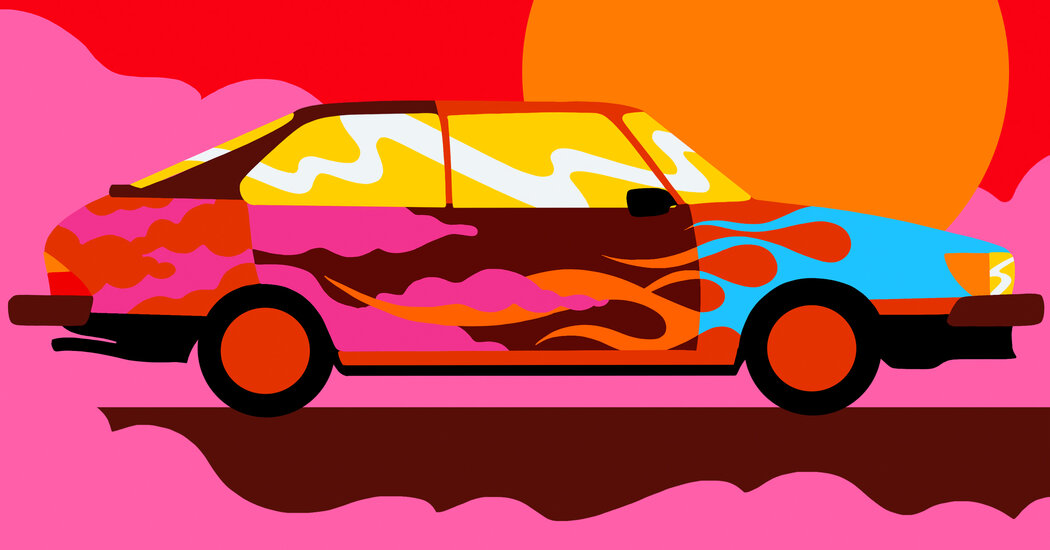The Unusual Cool of Saabs

The mechanic who sold me my first car accompanied me on the test drive near his shop in Northeast Portland. As I recall, he was selling it as a favor to an older woman he knew who had owned it for almost 20 years, and he wanted to make sure I was the right person for the car: a Talladega Red 1991 Saab 900. I felt suddenly nervous when I sank into the worn beige leather of the driver’s seat; I had only recently learned how to drive stick. While we idled, the mechanic turned off the radio so I could become familiar with the engine’s consistent, healthy purr. And when I eased it into first, he suggested that, in order to prolong the life of the transmission, I should hold the gearshift delicately, with only three fingers: thumb, forefinger and middle.
The careful movements seemed appropriate for operating a more complicated machine. And in fact, Saab originally manufactured fighter planes, before diversifying its business after World War II by making passenger vehicles. I like to think this aeronautical origin is part of the reason my old car — with its long front end and shortened hatchback — feels so otherworldly, so misshapen and strange. Its mechanics are also famously unusual: The engine starts while the car is in reverse; the ignition is in the center console instead of next to the steering wheel. On the headlights, you’ll find a pair of preciously small wiper blades that move in synchrony with the bigger ones on the windshield, which is curved like a cockpit’s.
Before I owned my Saab, I believed that all cars were either functional or luxurious. There was the Toyota Camry or the Porsche, the minivan or the sports car. But a Saab, modest and Scandinavian, exists on a different axis. My car is distinctly impractical and worth very little. It is coveted for intangible reasons — chiefly its eccentricity. Saab enthusiasts have been labeled Snaabs, a group sometimes characterized as like-minded, self-described nonconformists. Strangers on the street often share stories with me: My dad used to have one of those; I used to; she used to; we all used to. But I still do. My Saab is sitting in the driveway now, rusted but still running, asking me daily to consider what I would be giving up if I gave it away.
I bought my car from the mechanic in a hurry, before I knew anything about Saabs or their origin, but I suppose I’ve always had an indefensible love of what is unlikely or illogical. The Saab appealed to me in part because I have always thought of the unusual as cool. Over the past eight years, the challenge of keeping it running has cloaked me in the guise of a car person. I’ve broken down in my Saab on the side of a rural highway, on a steep neighborhood hill in Seattle, on a vacation in Detroit and after a rehearsal dinner on a farm in Oregon. As a result, I’ve learned how to change the headlights, replace the battery and repair cracked rubber engine hoses. Once, when smoke started pouring from under the hood while I was in Seattle traffic, a stranger taught me to cool the radiator with a jug of tap water while we stood on the shoulder of the Interstate. My dedication has paid dividends. Against all odds, my Saab has moved me from Portland to Minneapolis, back to Seattle and then to graduate school in rural Idaho.
Saab declared bankruptcy in 2011, so the Saabs on the road now will be the last. This inevitable extinction endows the cars with an added layer of significance. These days even I can admit that my car is a significant burden, financially and logistically. As I prepare for another move, I wonder how far it will get. I worry that I won’t be safe driving it at highway speeds. Recently, on a sunny day, I drove it to a nearby park listening to the Bonnie Raitt tape that has been in the car since I bought it. I went for a walk, and when I readied to leave, the Saab’s battery complained with a hopeless clicking. I shifted into neutral, then back into reverse. I turned the key again. Nothing.
The car has taught me a lot: not about cars in general, but about tending to its singular being. My commitment to its upkeep has raised the eyebrows of more than one person who loves me. It’s too old, too broken, too slow, not worth it. If a vehicle is meant to be only a dependable means for transportation, the Saab has failed me more than once. But I like to think of my car as endangered and animate, precious not for its convenience or use-value but for the history that it carries. The defiant care required to keep the Saab running has convinced me that it is possible to will something eccentric toward utility — to coax form into function. I ignore rust, expense and precarity in a hopeful protest against mere utility.
Though I’ve recently invested in a more reliable car — a Subaru — I struggle with getting rid of the Saab. In an effort to let go, I try to convince myself that the car is no more than a representation of time and its passing, a symbol for the youthful embrace of absurdity. Maybe I have outgrown it. I thought this once again as my Saab sat in that park, in reverse, unable to start. But then, as if it could hear me, the car started up again, sputtering to life before easing into the purring idle I practiced listening to years ago.
Georgia Cloepfilis a writer whose work has appeared in n + 1, Joyland, Epiphany and other publications.
